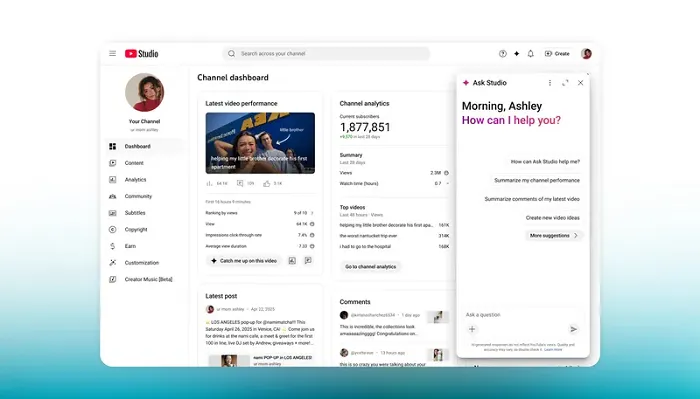AI at Scale: How Autonomous Coding, Robotic Systems, and Policy Are Shaping the Next Tech Era
Author: Editorial Desk

We are living through a moment when artificial intelligence ceases to be the province of researchers and becomes a practical engine for everyday decisions, product design, and policy debates. Across software, hardware, health, and media, AI is moving from assisted to autonomous modes of operation—capable of making decisions, coordinating tasks, and optimizing systems with minimal human direction. The last week alone offered a microcosm of this sprawling trend: software developers contemplating how to work alongside agents that can debug code and rewrite components; pharmaceutical researchers wielding AI to explore new degrader compounds at a pace that would have been unimaginable a decade ago; consumers encountering devices that adapt in real time to their homes and routines; and policymakers grappling with how to balance innovation with privacy, safety, and energy use. Taken together, these threads point to an AI-enabled future in which productivity, risk, and opportunity will be distributed unevenly, but in ways that are already reshaping how organizations plan, invest, and compete.
At the technical core of this transformation is the emergence of agentic AI—systems that can act on behalf of humans to accomplish multi-step tasks. The latest discussions around OpenAI's GPT-5 Codex describe a future where autonomous coding agents can troubleshoot a complex software stack, coordinate debugging across multiple tools, refactor code, and even generate orchestration logic for cloud deployments. The vision extends beyond a single tool to a network of agents operating in concert—millions of cloud-based programs that each handle a slice of a larger job, from testing and deployment to security monitoring and incident response. For software teams, the implication is profound: the boundary between writing code and managing code becomes increasingly porous as agents handle rote or error-prone tasks, leaving engineers to focus on design, architecture, and creative problem solving. But the shift also raises questions about governance, security, and the distribution of engineering talent, as organizations race to adopt agentic AI while carefully evaluating reliability, privacy, and the potential for unintended consequences.

An AI-powered coding environment illustrating agentic capabilities in software development.
Beyond software labs, AI is increasingly embedded in everyday devices and industrial systems, altering energy use and performance. Take Dyson's V16 Piston Animal vacuum, which uses an intelligent sensor suite to detect floor type and tailor its suction profile. The result is deeper cleaning with less wasted battery, a practical demonstration of how AI-informed perception, decision-making, and actuation can translate into tangible efficiency gains in consumer hardware. The broader trend is clear: devices equipped with lightweight AI models and onboard sensing can optimize routines (cleaning, heating, ventilation, etc.) without relying on remote servers for every decision. This shift chips away at the old dichotomy between 'smart' devices that require constant connectivity and 'dumb' appliances that do the same thing no matter the context. As households adopt smarter machines, the cumulative effect on energy consumption, maintenance costs, and user experience becomes a practical driver of AI adoption in the home and office alike.
Dyson V16 Piston Animal adapting to different floor surfaces to optimize cleaning and battery use.
Meanwhile, the life sciences industry is expanding AI-driven discovery into practical partnerships. Novartis has entered into a significant collaboration with Monte Rosa, aiming to develop an unspecified number of degraders using Monte Rosa’s Quantitative and Engineered Elimination of Neosubstrates (QuEENTM) platform. In essence, AI is helping design and test novel molecules that can selectively disable disease-causing proteins, accelerating the pace of early-stage discovery. This is not research in theory but a structured industrial partnership that signals how large pharma may increasingly rely on AI-powered engines to explore vast chemical spaces far more quickly than traditional methods. The implications reach beyond speed: improved predictive accuracy in target engagement, a more efficient allocation of lab resources, and new questions about safety, regulatory oversight, and the ethical dimensions of AI-guided medicine. The collaboration situates AI as a central pillar in the next generation of drug discovery, a trend that could redefine how therapeutics move from bench to bedside.
At the same time, corporate adoption of AI raises concerns about jobs and inequality. Fresh data from Anthropic’s Economic Index suggests that firms are leaning into automation for routine tasks, potentially threatening entry-level roles. The data imply a broader shift in labor markets: as algorithms shoulder more decision-making and repetitive work, the demand for human labor in lower-skill positions could compress, even as new roles in AI oversight, data curation, and model governance emerge. The debate is far from theoretical. For educators and policymakers, it translates into questions about how to retrain workers, how to structure career ladders, and how to ensure that the benefits of AI adoption are broadly shared rather than captured only by a few organizations. Critics warn that automation without adequate social safeguards could widen income disparities, while proponents point to productivity gains, new business models, and the potential for AI to augment rather than replace human labor in many domains.

Anthropic Economic Index and automation trends implicated in Gen Z employment concerns.
As policy makers weigh the pace of AI deployment, governance conversations move from theory to politics. In the United States, high-profile policy initiatives have sparked intense debate. President or former President Trump’s AI Action Plan has elicited both support and protest from different factions, reflecting a broader struggle to balance competitiveness with safeguards. At the same time, global platforms are experimenting with AI-enabled features that reshape content creation and distribution; updates and integrations announced by major platforms illustrate how AI is becoming a standard tool in marketing, media production, and consumer services. The central questions are not merely about capability but about accountability: how to ensure algorithmic transparency, guardrails for bias and privacy, and mechanisms to monitor energy use and environmental impact as models scale. As more organizations rely on AI to interpret data, automate workflows, and interact with users, policy and industry will need to evolve in tandem to sustain trustworthy innovation.

YouTube updates rolled out at Made On 2025, highlighting AI-enabled tools for creators.
Across education, regional initiatives are attempting to bridge the AI skill gap. MTN Ghana's DigiFest program demonstrates how corporations are investing in digital skills to empower students and communities. The initiative aims to equip young people with AI literacy and practical digital capabilities, fostering innovation and inclusion in the Ghanaian technology ecosystem. Such programs provide a model for public-private partnerships that can help prepare the next generation for an AI-enabled economy, emphasizing hands-on learning, coding, and critical thinking. As more regions implement similar programs, questions of curriculum relevance, access to computational resources, and the role of schools in preparing students for AI-centric workplaces come to the fore.

MTN Ghana DigiFest highlights the role of AI in education and youth empowerment.
Finally, the space mapping article reveals how far computational frontiers may be pushed with increasingly accessible hardware. A new emulator promises to map the universe’s large-scale structure in minutes on a laptop, challenging the assumption that only supercomputers can simulate cosmic evolution with high fidelity. If such capabilities become more routine, researchers could explore larger volumes of space, test new theories of structure formation, and democratize access to cutting-edge cosmology. Taken together, the pieces of this mosaic point to an AI-enabled future that will be as much about governance, ethics, and education as about silicon and software. The promise is immense: speed and insight across domains that once required enormous capital investments. The risk is real: uneven access, potential job displacement, privacy concerns, and energy consumption. The challenge for societies will be to steer this momentum toward broadly shared gains, ensuring that innovation serves people, communities, and the planet.